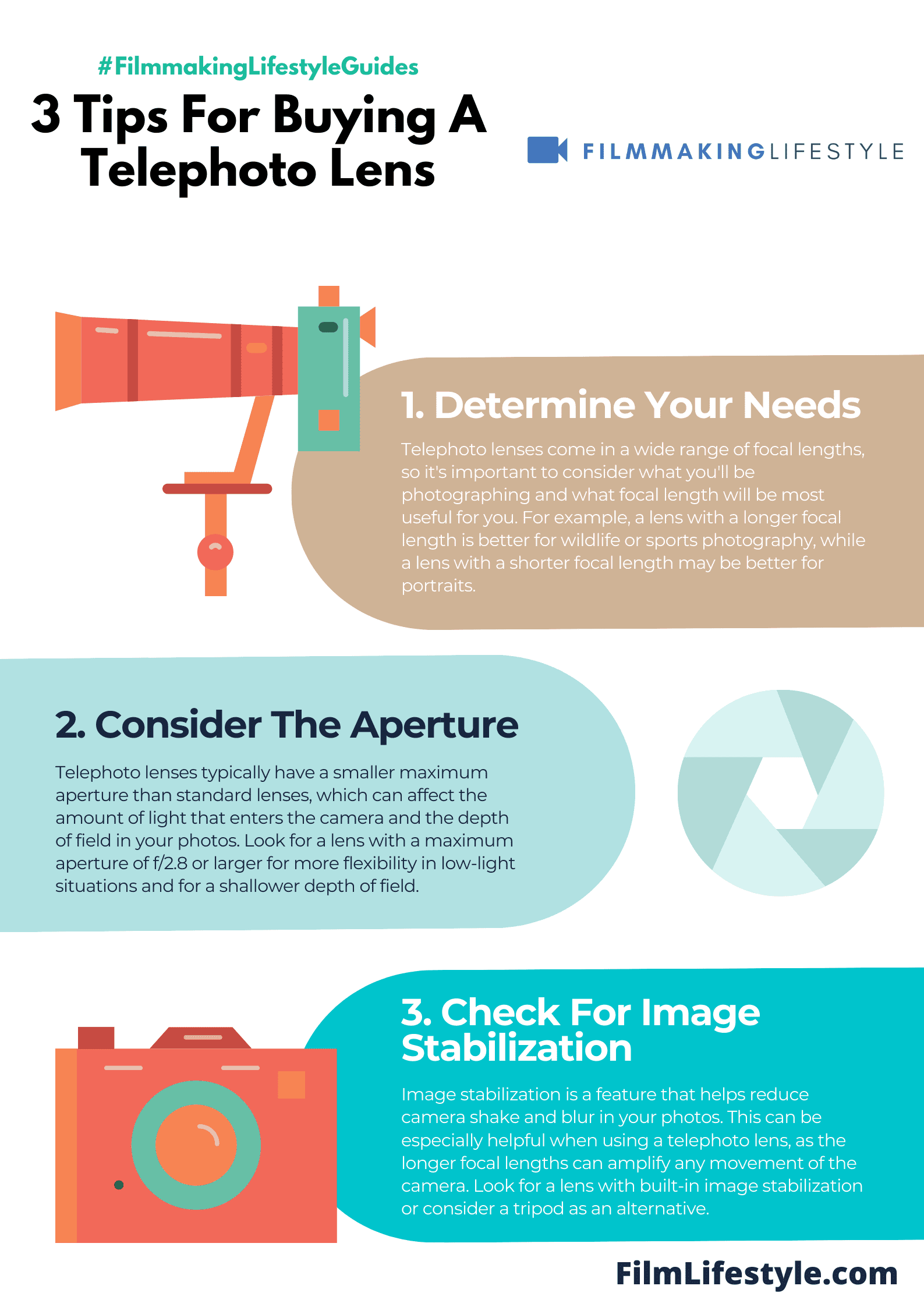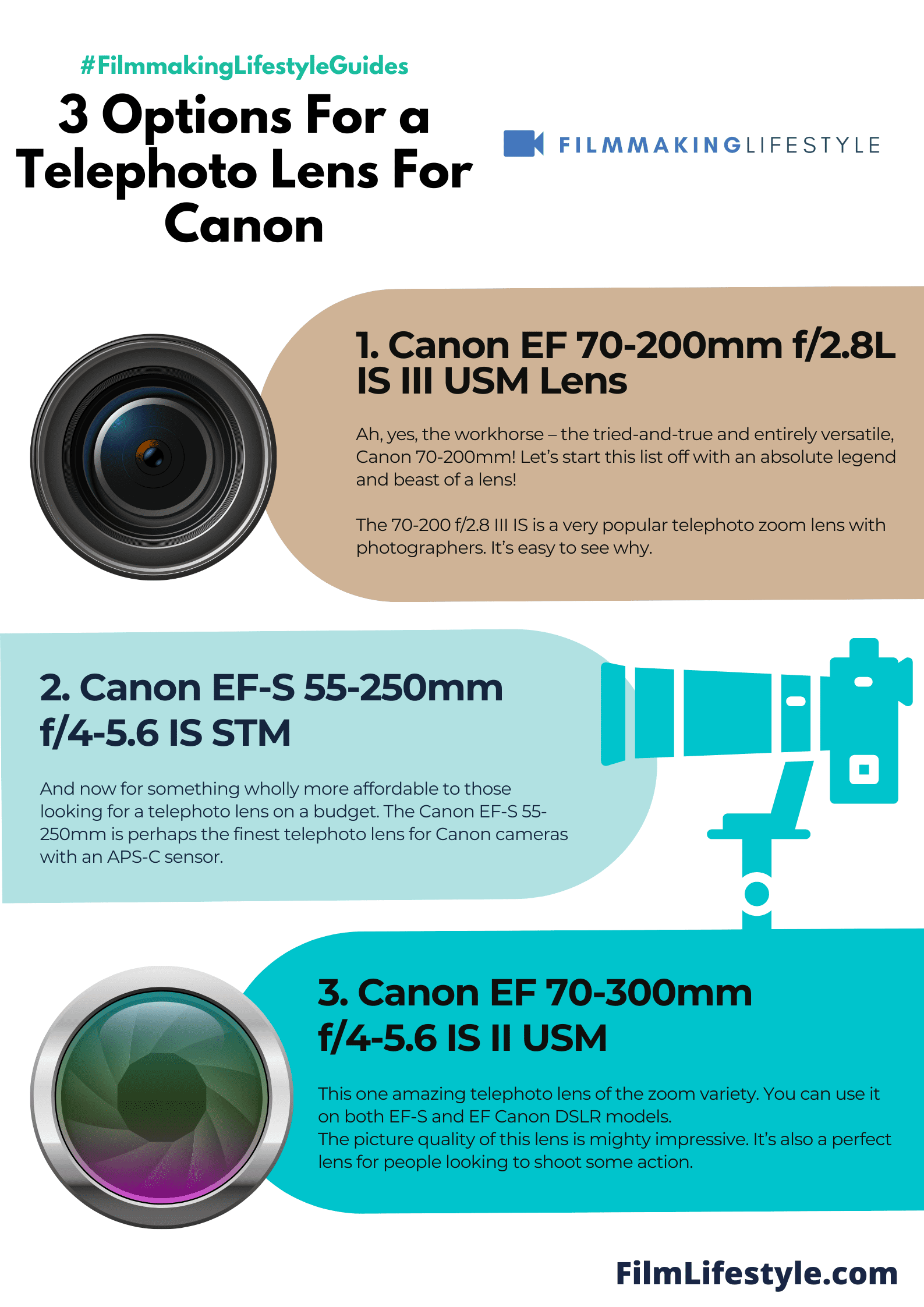Some say that the photographer makes the camera. We say the photographer/videographer and the equipment make the camera. There’s only so much a skilled photographer can accomplish with a camera that lacks any equipment to optimize it.
If you’re worked at all with telephoto lenses then you’ve probably asked yourself what’s the best telephoto lens for canon.
Take for instance action photography. Let’s say you want to shoot a fast-running animal in the wild.
It would be impossible to accomplish that with a slow motor lens or god forbid, without a lens at all.
With that said one of the most important lens types is the telephoto lens. Telephoto lenses are important for shooting subjects from a distance.
Before you buy one, you’ll need to consider a few things and know what you’re getting and what it can and cannot accomplish.
That’s why today we compiled a guide on telephoto lenses for Canon. We’re going to talk about what you need to know before buying and list some of our favorite lenses for your consideration.
So, without further ado let’s dive in.
With all this said, let’s take a look into some of our favorite telephoto lenses for Canon we’re sure will please even the pickiest of photographers.
Best Telephoto Lens For Canon
Let’s jump into our list of the best Canon telephoto lenses with the awesome and ever-reliable Canon EF 70-200mm! If you haven’t used this beast yet, then you’re in for a treat!
1. Canon EF 70-200mm f/2.8L IS III USM
Optical and Image Quality
The Canon EF 70-200mm f/2.8L IS III USM lens, as part of Canon’s prestigious L-series, lives up to its reputation for delivering top-tier optical performance.
It boasts a constant f/2.8 aperture throughout its zoom range, making it incredibly versatile for various lighting situations.
The optics are sharp, and chromatic aberrations are well-controlled, even at its widest aperture.
The inclusion of the Air Sphere Coating (ASC) aids in reducing flares and ghosting, ensuring that images come out with excellent contrast and clarity.
Build and Design
When it comes to build quality, the lens embodies the L-series standard with its sturdy and weather-sealed construction.
It’s designed to withstand the rigors of professional use, being resistant to both dust and moisture.
The tactile zoom and focus rings provide a smooth operation, allowing for precise adjustments.
Weighing approximately 1,480 grams, the lens is not the lightest, but its robust build gives photographers the confidence to use it in various environments without much concern.
Image Stabilization and Autofocus
The lens is equipped with Canon’s Optical Image Stabilizer system, which claims up to 3.5 stops of shake correction.
This feature is invaluable, especially when shooting at slower shutter speeds or when videography is the task at hand.
On the autofocus front, the EF 70-200mm f/2.8L IS III USM uses a ring-type Ultrasonic Motor (USM).
This system ensures speedy, silent, and accurate autofocus.
The full-time manual focus override is also available, allowing photographers to make on-the-fly adjustments without switching out of autofocus mode.
The Canon EF 70-200mm f/2.8L IS III USM is undeniably a workhorse in Canon’s lineup.
It combines exceptional optical quality with a robust build, making it an ideal choice for professionals and enthusiasts alike.
The added benefits of image stabilization and a top-notch autofocus system make it a versatile lens for a variety of scenarios, from portraiture to sports photography.
Its price tag might be on the higher side, but for those who require the pinnacle of performance in this focal range, it’s a worthy investment.
- Constant f 2.8 Maximum Aperture throughout Entire Zoom Range.
- Canon’s Air Sphere Coating (ASC) Minimizes Ghosting and Flare.
- Optical Image Stabilization at up to 3.5 Stops of Shake Correction.
- Fluorine Coating on Front and Rear Elements to Help Reduce Smears and Fingerprints.
- Highly Resistant to Dust and Water, and Improved Durability Even in Harsh Conditions. Inner Focusing...
2. Canon EF 200mm f/2L IS USM
Optical and Image Quality
Canon’s EF 200mm f/2L IS USM stands as an exemplary piece of prime telephoto engineering within the esteemed L-series lineup.
The lens’s wide f/2 aperture isn’t just for show; it delivers impeccable sharpness and clarity, even when wide open.
This bright aperture also ensures creamy and smooth bokeh, allowing subjects to stand out remarkably against a beautifully blurred background.
The use of ultra-low dispersion elements further refines image quality, minimizing chromatic aberrations and enhancing overall contrast and color fidelity.
Build and Design
Synonymous with Canon’s L-series tradition, the lens boasts a solid and professional build.
The design is robust, with weather sealing to guard against dust and moisture, allowing photographers to confidently operate in challenging environments.
While its physical size and weight might seem hefty to some, it’s a testament to its solid construction and the high-quality optics housed within.
Ergonomically, the lens offers a set of controls, including a focus limiter and stabilization modes, positioned intuitively for quick adjustments during shooting.
Image Stabilization and Autofocus
One of the standout features of this prime lens is its Optical Image Stabilization (IS) system, which provides up to 4 stops of shake correction.
This feature is particularly valuable given the lens’s telephoto nature, allowing for sharper handheld shots even in less-than-ideal lighting conditions.
Autofocus, driven by the Ultrasonic Motor (USM), is lightning fast, silent, and precise.
The lens snaps onto subjects effortlessly, making it ideal not just for portraiture but also for action and sports photography.
The Canon EF 200mm f/2L IS USM is a testament to Canon’s prowess in lens design and optical performance.
While its premium pricing might deter some, its performance justifies every penny.
Offering superb optics, a robust build, and advanced features, this lens stands out as a top-tier choice for professionals and serious enthusiasts alike.
For those seeking impeccable image quality combined with a bright aperture in a telephoto prime, the EF 200mm f/2L IS USM is hard to surpass.
- Package Dimensions : 43.18 H x 30.988 L x 35.052 W (centimeters)
- Made in Japan
- Package Weight : 1.0 pounds
BEST TELEPHOTO LENS FOR CANON
What Are Telephoto Lenses?
Telephoto lenses are a specialized type of lens that is used to capture subjects from a distance. They have a long focal length and are oftentimes the only option for capturing wildlife or sports events from far away.
Telephoto lenses also come in handy when you need to zoom in on a subject without having to physically move closer, like with sporting events or concerts where you don’t want to disturb others sitting nearby.
If you’ve ever been to a concert or sporting event and wanted to take the perfect picture of your favorite band or athlete, then you know that it can be hard with so many people in the way.
Telephoto lenses are designed for this exact purpose: they have a longer zoom and capture more detail than regular-sized lenses.
3. Tamron SP 70-200mm f/2.8 Di VC USD G2
Optical and Image Quality
The Tamron SP 70-200mm f/2.8 Di VC USD G2 emerges as a robust contender in the realm of telephoto zoom lenses.
Its constant f/2.8 aperture across the zoom range ensures consistent brightness and facilitates low-light photography.
The lens produces images that are sharp, with well-controlled chromatic aberrations, courtesy of its advanced optical construction.
The color reproduction is vibrant, and the bokeh quality, given the aperture, is smooth and pleasing, making it ideal for portraiture and subject isolation.
Build and Design
Tamron’s commitment to quality shines through in the lens’s construction.
The exterior feels durable and is complemented by weather-sealing, which safeguards against moisture and dust.
This feature is particularly beneficial for photographers who frequently shoot outdoors.
The lens also sports a sleek and modern design, with tactile zoom and focus rings that enable smooth operation.
Tamron has also integrated an Arca-Swiss style tripod interface, which allows for direct attachment to tripod plates, enhancing its usability.
Image Stabilization and Autofocus
One of the highlights of the lens is its Vibration Compensation (VC) system.
This image stabilization feature is optimized to provide up to 5 stops of shake correction, a boon for handheld shooting at slower shutter speeds.
When it comes to autofocus, the lens employs an Ultrasonic Silent Drive (USD) motor, which ensures rapid and quiet focusing.
The focus accuracy is commendable, and with its full-time manual focus override, photographers can make minute adjustments seamlessly.
The Tamron SP 70-200mm f/2.8 Di VC USD G2 stands tall as an excellent alternative to some of the pricier counterparts in its category.
While it might not bear the branding of mainstream camera giants, its performance, build quality, and features speak volumes.
This lens offers a compelling mix of optical prowess, effective stabilization, and a responsive autofocus system, all packaged in a robust design.
For photographers seeking a versatile telephoto zoom without breaking the bank, the Tamron SP 70-200mm f/2.8 G2 emerges as a worthy contender.
- VC performance is 5 stops (VC mode 3) and offers three modes optimized for different shooting...
- MOD reduced to 37.4" (1:6.1 max. mag. Ratio). Angle of view (diagonal): 34°21' - 12°21'(for...
- Lightweight and easy-to-hold tripod mount is compatible with an Arca-Swiss style quick release plate
- Compatible with TAMRON TAP-in Console, an optional accessory product; The front surface of the lens...
- Teleconverters (optional) compatible with this new Tamron lens.Aperture Blades:9 (circular...
4. Canon EF 70-200mm f/4L USM
Optical and Image Quality
The Canon EF 70-200mm f/4L USM is a hallmark of optical precision within Canon’s esteemed L-series.
Even though it sports a slightly narrower aperture compared to its f/2.8 sibling, it doesn’t compromise on image clarity and sharpness.
Throughout its zoom range, this lens maintains consistent performance, delivering vibrant colors and crisp details.
The integration of one fluorite and two UD elements ensures chromatic aberration is well-controlled, resulting in images that exhibit high contrast and resolution.
Build and Design
As part of the L-series lineup, this lens features the signature build quality Canon enthusiasts have come to expect.
Its construction feels robust, with a body that is resistant to dust and moisture – ideal for outdoor photography sessions.
The lens has a compact and lightweight design, which makes it an attractive option for those who prioritize portability without wanting to sacrifice on image quality.
The focus and zoom rings operate smoothly, allowing for precise adjustments during intensive shooting scenarios.
Autofocus Performance
The lens employs Canon’s Ultrasonic Motor (USM) to drive its autofocus mechanism.
The result is a system that’s both swift and quiet.
Whether you’re capturing stills or recording videos, the AF transitions smoothly from one point to another without distracting noise.
The precision is noteworthy, with the lens consistently achieving sharp focus on subjects, even in challenging lighting conditions.
The manual focus override feature further allows photographers to fine-tune focus effortlessly.
The Canon EF 70-200mm f/4L USM establishes itself as a stellar choice for those seeking a versatile telephoto zoom lens that strikes a balance between performance, build, and portability.
Its optical quality, combined with the reliability of the L-series construction, makes it an invaluable tool for various photography genres, from portraits to landscapes.
For photographers who require a lightweight yet high-performing telephoto lens and are content with the f/4 aperture, this lens emerges as a top contender in its class.
- 70-200mm telephoto zoom lens with f/4 maximum aperture for Canon digital SLR cameras
- Fluorite UD lens elements produce excellent optical performance in resolution and contrast, Closest...
- Ring-type ultra-sonic monitor (USM) for quick and quiet autofocusing; lightweight construction
- Image Stabilizer provides up to 4 stops of shake correction; water- and dust-proof construction
- Measures 3 inches in diameter and 6.8 inches long; Weight : 1.675 pounds (lens only) ; 1-year...
5. Canon EF 100-400mm f/4.5-5.6L IS II USM
For those who find themselves needing an extended reach, the Canon EF 100-400mm f/4.5-5.
6L IS II USM is a stellar pick.
It’s synonymous with versatility and image quality that meet the demands of serious wildlife and sports filmmakers.
One of its standout features is the four-stop Image Stabilizer.
This technology is ideal for reducing camera shake, essential when filming at long focal lengths or in low light conditions.
The EF 100-400mm also boasts an impressive L-series construction – ensuring robustness that’s key on varied shooting locations.
This lens is equipped with a fast and near-silent autofocus system.
There’s also the convenient option for manual focus override, allowing us to fine-tune the focus for critical sharpness – an attribute we can’t understate, especially for capturing decisive moments.
Let’s highlight the Air Sphere Coating (ASC).
It significantly reduces backlit flaring and ghosting So preserving contrast and clarity.
Below are key features that make this lens a top contender for filmmakers:
- Outstanding image quality across the entire zoom range
- Durable build, with weather-sealing to brave the elements
- Remarkable Image Stabilization for the steady footage
- Versatile zoom range – from portraits to distant subjects
With its push-pull zooming mechanism, it’s quick and intuitive to get the framing just right.
also, the zoom torque adjustment ring allows us to customize the zoom feel to our preference.
When it comes to crisp visuals and robust reliability, the Canon EF 100-400mm f/4.5-5.6L IS II USM doesn’t disappoint.
It’s a worthwhile investment for our kit, providing us with flexibility and quality that can elevate our film production to new heights.
6. Canon EF 70-300mm f/4-5.6 IS II USM
For filmmakers who need a balance between performance and portability, the Canon EF 70-300mm f/4-5.6 IS II USM is a compelling choice.
It boasts a versatile zoom range that’s perfect for interviews, wildlife, and tight detail shots on a budget.
The optical quality is impressive, delivering clear and vibrant images from edge to edge.
Canon’s Nano USM motor ensures fast, silent autofocus, which is a necessity when recording video to avoid any unwanted noise disrupting a scene.
Some of its standout features include:
- A new LCD information display that shows focusing distance, focal length, and shake amount
- Image Stabilization up to 4 stops, vital for maintaining image sharpness, especially in low light conditions
We can’t overstate the convenience of this telephoto lens’s relatively lightweight design.
It makes it a great companion for run-and-gun filmmaking, where quick setup and mobility are essential.
Durability isn’t compromised for the sake of weight.
The lens is built solidly, and while it’s not part of the L-series, it still manages to hold its own in varied shooting environments.
So, while the Canon EF 70-300mm may not rival the prowess of the higher-end L-series lenses in some regards, it’s affordability and performance make it a smart choice for filmmakers who need to capture distant subjects on the move.
With this lens, we’re equipped to produce stunning telephoto footage without the need to invest heavily in pricier equipment.
7. Sigma 150-600mm f/5-6.3 DG OS HSM Contemporary
For filmmakers in search of unrivaled reach without very costly, the Sigma 150-600mm f/5-6.
3 DG OS HSM Contemporary lens emerges as a formidable contender.
Its staggering zoom range opens up endless creative possibilities, transforming distant scenes into striking visuals.
Durability meets versatility in this lens, designed to withstand the rigors of fieldwork.

The dust and splash-proof construction ensures it keeps pace with the demanding environments of outdoor shoots.
Optimized for high-resolution films, this Sigma lens delivers consistently sharp footage across the entire zoom range.
The Optical Stabilizer (OS) feature is instrumental in enabling smooth handheld filming, a must-have for dynamic storytelling.
Speed is of the essence when capturing fleeting moments.
The Hyper Sonic Motor (HSM) ensures rapid and silent autofocus, crucial when the action is unpredictable and sound integrity cannot be compromised.
In terms of operability, Sigma’s 150-600mm lens is a testament to user-friendly design:
- Zoom Lock switch – prevents the lens from extending due to its own weight
- Manual override (MO) – facilitates seamless switching between auto and manual focus modes
- Customization – available via the Sigma USB dock for personal preference adjustments
Filmmakers who rely on Sigma’s 150-600mm f/5-6.3 DG OS HSM Contemporary lens can attest to its outstanding performance.
It’s the bridge between capturing a distant scene as a mere backdrop and bringing it to the forefront of cinematic excellence.
So, whether it’s a wildlife documentary or a sports feature, this lens unquestionably deserves a spot in your filmmaking arsenal for its sheer scope and optical prowess.
8. Canon EF 400mm f/5.6L USM
When delving into the world of telephoto lenses for filmmaking, the Canon EF 400mm f/5.6L USM stands out for its unique features.
Its focal length is specifically advantageous for capturing distant subjects, making it an essential tool for wildlife and sports cinematography.
The lens’s reputation for sharpness is well-deserved.
The images produced are crisp and clear, a crucial aspect for high-resolution video footage.
With the 400mm focal length, we’re able to compress and flatten the scene, enhancing the cinematic feel of our productions.
Durability is a key factor with the Canon EF 400mm f/5.6L USM, thanks to its L-series build.
The solid construction paired with a built-in lens hood makes it a reliable companion for outdoor shoots.
The lightweight design ensures that mobility isn’t compromised while on the move.
Speed and performance go hand in hand with this lens.
The USM, or Ultrasonic Motor, provides fast and precise autofocus,
This is especially beneficial when filming unpredictable, fast-moving subjects.
Key attributes of the Canon EF 400mm f/5.6L USM:
- Exceptional sharpness and clarity
- Durable, L-series construction – Rapid and accurate autofocus
While it lacks optical image stabilization, we find that its other features more than make up for this shortcoming.
With proper technique and support gear such as tripods or gimbals, stability can be effectively managed.
Optimized for both full-frame and APS-C formats, this lens is a versatile addition to our gear list.
It ensures that, regardless of the camera body we pair it with, the results are consistently outstanding.
Incorporating the Canon EF 400mm f/5.6L USM into our filmmaking rig opens up possibilities for capturing those distant, sometimes fleeting cinematic moments.
Whether we’re after the grace of a distant animal or the intensity of an athlete in motion, this lens doesn’t just reach the action, it brings it into focus, allowing us to draw the viewer in from afar.
9. Sigma 120-300mm f/2.8 DG OS HSM Sports
For filmmakers looking to push the boundaries of their Canon cameras, the Sigma 120-300mm f/2.8 DG OS HSM Sports is a lens that deserves attention.
This lens stands out for its exceptional range and fast continuous aperture, making it a powerhouse for sports and wildlife cinematography.
The optical stabilization system is a highlight, allowing for seamless shots even when capturing fast-moving subjects at long distances.
Our shoots benefit from sharper footage thanks to this cutting-edge technology, providing a reliability that’s crucial during dynamic filming sessions.
We find the construction of the Sigma 120-300mm f/2.8 DG OS HSM Sports is both sturdy and ergonomic.
The lens has a dust and splash-proof design ensuring durability which is essential for outdoor filmmaking environments.
Designed with a Hyper Sonic Motor (HSM), autofocus is both swift and silent.
This is particularly beneficial when recording sound-sensitive scenes where any noise could disturb the atmosphere or disrupt the narrative flow.
In terms of image quality, directors and cinematographers can expect:
- Superior contrast and color fidelity
- Minimal chromatic aberration due to its advanced lens elements
The Sigma 120-300mm f/2.8 is compatible with Sigma’s USB Dock which allows for firmware updates and focus adjustments, a feature that adds to the lens’s adaptability.
Customization is key in our industry, and the ability to fine-tune lens settings to our specific needs is a definitive plus.
Equipped with a constant f/2.8 aperture, this lens excels in low-light situations without compromising on shutter speed.
It’s this kind of versatility that can make or break a shot when we’re looking to capture the perfect take under challenging light conditions.
10. Canon EF 300mm f/4L IS USM
When seeking stellar performance for sports and wildlife scenes, the Canon EF 300mm f/4L IS USM stands out.
This prime lens delivers sharpness and clarity that’s essential for high-impact footage.
Its built-in Image Stabilizer (IS) technology is a game changer.
This feature enables us to capture smooth, steady shots even when handheld, which is indispensable for dynamic filmmaking.
Canon’s build quality doesn’t disappoint.
The EF 300mm f/4L IS USM is durable and sealed against the elements, making it a reliable choice in challenging outdoor conditions.
Autofocus is quiet and quick, thanks to the Ultrasonic Motor (USM).
Accurate focusing allows us to capture fleeting moments with precision, a must-have for fast-paced action sequences.
Here are some advantages of using this lens:
- Consistent output across various lighting conditions
- Reduced chromatic aberration due to the UD (Ultra-low Dispersion) lens element
- Lightweight construction relative to its focal length, enabling better maneuverability during shoots
The non-rotating front element simplifies the use of polarizing filters.
This aspect is particularly useful for managing reflections and improving saturation in our visuals.
The ability to lock focus quickly is critical when the action won’t pause for us.
With its super-responsive autofocus, the Canon EF 300mm f/4L IS USM ensures we’re always ready to capture the scene at a moment’s notice.
Offering a focal length that brings distant subjects closer, this lens is a powerful tool.
It allows us to maintain a discreet distance without compromising image quality, which is ideal for naturalistic and candid captures in our films.
Versatility is a strong suit of the EF 300mm f/4L IS USM.
While designed for photography, its features translate well into our film productions, providing us with stunning visuals that enhance our storytelling.
11. Tamron 100-400mm f/4.5-6.3 Di VC USD
As filmmakers, we’re always on the hunt for lenses that offer versatility and quality without very costly.
Enter the Tamron 100-400mm f/4.5-6.3 Di VC USD – a lens that’s quickly gaining popularity among Canon users for its remarkable zoom range and commendable image stabilization.
With a weight of just 1.11kg, it’s one of the lightest lenses in its class, making it ideal for on-the-go shoots and lengthy film projects.
The Tamron’s optical performance is a key highlight, producing sharp footage across its focal range.
Its Vibration Compensation (VC) is outstanding, indispensable for maintaining stable shots during handheld filming or when capturing subjects from a distance.
also, its Ultrasonic Silent Drive (USD) autofocus motor is both speedy and silent, a must for maintaining the natural soundscape of your scene.
Some of the standout features of this lens include:
- Moisture-Resistant Construction for durability in challenging weather conditions
- Dual MPU (Micro-Processing Unit) for improved autofocus precision and VC
- eBAND Coating to reduce flare and ghosting, ensuring clear image quality
Professionals filming wildlife documentaries or sports events will appreciate the Tamron’s reach and responsiveness.
The flexibility of having a 100-400mm range means that we can adjust our composition and framing quickly, capturing spontaneous moments without needing to switch lenses.
The f/4.5-6.3 aperture range provides balanced performance in varied lighting situations, although it demands more light than lenses with larger maximum apertures.
The Tamron 100-400mm is not just for capturing distant subjects.
Its minimum focus distance of 1.
5m allows us to get reasonably close to the action while the background fades into a pleasing bokeh, adding cinematic depth to our shots.
The result is footage that’s both dynamic and engaging, vital for keeping the viewer’s attention.
12. Canon EF 180mm f/3.5L Macro USM
When we jump into the world of macro filmmaking, the Canon EF 180mm f/3.5L Macro USM emerges as a heavyweight contender.
Its telephoto reach and macro shooting capabilities enable us to capture stunning close-ups with cinematic detail.
This lens is a workhorse in both clarity and build.
Its superior magnification – up to 1:1 or life-size – allows us precise control over our subject matter.
Boasting an ultra-low dispersion (UD) element, the EF 180mm f/3.5L Macro USM delivers sharp, high-contrast images.
The inner focusing mechanism meaning we can adjust the composition without altering the lens’ physical length.
Crucially for our filmmaking endeavors, it’s the kind of lens that’s built to perform under pressure.
The ring-type Ultrasonic Motor (USM) provides quick, silent autofocus which is essential when capturing delicate, natural sequences.
For filmmakers, this lens presents unique opportunities –
- Achieve intricate detail shots without disturbing the scene
- Create profound visual narratives where every detail counts
While it’s a prime lens, the 180mm focal length gives it ample reach.
Perfect for scenes in nature documentaries or when you want that intimate perspective without getting too close.
With its solid build quality, the Canon EF 180mm f/3.5L Macro USM is reliably sharp and a valuable addition to our arsenal.
It’s weather-sealed too, ensuring we get the shot regardless of the elements.
Versatile in function but specialized in its macro abilities, this lens lets us explore a whole new dimension of filmmaking.
Having the capacity for both telephoto precision and life-size magnification opens up a plethora of creative possibilities.
13. Sigma 100-400mm f/5-6.3 DG OS HSM Contemporary
As filmmakers, we’re continually on the lookout for gear that brings versatility without sacrificing quality.
The Sigma 100-400mm f/5-6.3 DG OS HSM Contemporary is one such lens that combines a broad telephoto zoom range with outstanding portability.
It’s an exceptional choice for those needing to capture diverse scenes, from landscapes to wildlife, without changing lenses.
Boasting Optical Stabilization (OS) technology, this Sigma lens helps us achieve stable shots even when shooting handheld.
This is crucial during long filming days or when tripods and monopods aren’t feasible.
Its Hypersonic Motor (HSM) guarantees quick and silent autofocus, a must for ensuring that we never miss a spontaneous moment.
Crafted with four SLD (Special Low Dispersion) glass elements, the image quality remains top-notch across the entire zoom range.
Key features include:
- Optical Stabilization for shake-free recording
- Hypersonic Motor for swift and silent focusing
- Zoom lock switch to prevent lens creep when not in use
We find that its contemporary design isn’t just about looks.
The weather-sealed mount provides a layer of protection against the elements, giving us more confidence when shooting in less than ideal weather conditions.
With its push/pull zoom mechanism, transitioning between focal lengths is seamless, keeping us focused on capturing the narrative without interruption.
The Sigma 100-400mm f/5-6.3 is adaptable with Sigma’s USB dock for fine-tuning different lens parameters.
This adaptability is perfect for filmmakers who demand precise control over their lens performance.
Whether it’s filming an indie project or a commercial gig, this lens adapts effortlessly, making it a smart addition to our equipment list.
14. Canon EF 70-300mm f/4.5-5.6 DO IS USM
We’ve explored a variety of telephoto lenses and can’t overlook the unique Canon EF 70-300mm f/4.5-5.6 DO IS USM.
This lens stands out in our collection with its Diffractive Optics (DO) technology, making it uniquely compact and lightweight.
When shooting on the move, weight and size are crucial.
The DO technology significantly reduces chromatic aberrations.
This results in a lens that’s both smaller and provides impeccable image quality, a combination that’s hard to find in telephoto zoom lenses.
Its Image Stabilizer (IS) technology is a boon for filmmakers.
It allows us to shoot stable footage even when handheld.
The lens provides up to three stops of shake correction, a feature invaluable during lengthy shoots where tripods aren’t an option.
Fast autofocus (AF) is a must for capturing the unpredictability of live action.
The Canon EF 70-300mm uses an Ultra-Sonic Motor (USM) that guarantees quick and near-silent AF.
Filmmakers will appreciate the ability to switch from AF to manual focus with a simple twist of the focus ring.
Advantages of the Canon EF 70-300mm f/4.5-5.6 DO IS USM:
- Compact size due to DO technology
- Excellent image stabilization with up to three stops of correction
- Swift and silent Autofocus thanks to USM
Our hands-on experience tells us that the Canon EF 70-300mm is an asset on set.
Its versatility makes it suitable for a variety of filming scenarios from wildlife documentaries to dynamic sports action.
Durability is a consideration we can’t ignore.
This lens has a solid build that’s reassuring for frequent use.
Its moisture resistance adds an extra layer of protection against the elements, ensuring it performs consistently in diverse shooting conditions.
By integrating the Canon EF 70-300mm f/4.5-5.
6 DO IS USM into our gear, we’re well-equipped to produce high-quality footage.
Whether we’re looking for portability, performance, or precision, this lens has proven its place in our professional toolkit.
BEST TELEPHOTO LENS FOR CANON
Advantages of Telephoto Lenses
• Capture more detail from a distance.
• Decrease camera shake in lower light settings.
• Get that perfect video or photo regardless of the environment.
• Get an up-close view of the world with beautiful clarity.
• Capture photos of objects in motion that would otherwise be impossible to photograph.
What To Consider Before Buying
Now let’s take a moment to look at some of the buying considerations you might have when thinking about purchasing a Canon telephoto lens.
Action vs. Static
Do you want to shoot subjects in action or in a static state? This distinction can save you a lot of money if you know what you want.
If you want to shoot static images, you can get a cheaper lens with a slower motor.
However, if shooting action is what you want, then you should consider spending more on a camera with a fast motor. This will save you the money spent on upgrading your lens as time goes on.
Image Quality
This is going to be what matters most to you. Therefore, you need to know what kind of image your lens produces.
While specs are a good indication, we recommend that you look at images taken with the lens you’re interested in. After all, the eye is the best judge.
Prime vs. Zoom
Zoom lenses are pretty self-explanatory. The lens allows you to zoom in on the subject for better framing. They are versatile as they allow you to take images in different aspect ratios and modes.
The tradeoff is that you’ll lose some resolution and detail the more you zoom in. Also, the fact that zoom lenses can do a lot of things well, doesn’t mean it can do any of em exceptionally well.
Prime lenses are the opposite. You can’t zoom as there’s only one focal length. While they’re not as versatile as zoom, they are more consistent in their image quality.
The limitations don’t set the prime lens back. Instead, they force you to move around the scenery and come up with more interesting solutions rather than lazily zooming in all the time.
Best Telephoto Lens For Canon – Wrapping Up
This concludes our guide on the best telephoto lens for Canon. It’s easy to see that Canon itself has you covered on all fronts.
Regardless of what you need, Canon has it. The rest depends on you.
Ask yourself what’s your budget and what do you want out of your lens:
- Do you want great performance and couldn’t care less for portability?
- Maybe the IS III USM is the lens for you.
- Do you want portability and autofocus that’ll capture fast-moving subjects?
Our first pick, the IS STM might be just what you need.
All in all, the most important aspect of a telephoto lens is to support your needs. Everything else is just a bonus. At the end of the day, enjoying the lens is what matters most.
We have Gear Buyer’s Guides on every type of Filmmaking Equipment!












